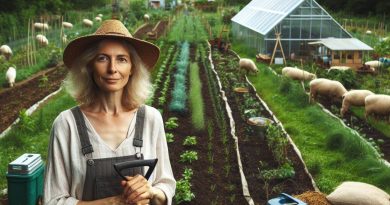Eco-Farms: Boosting Biodiversity Easily
Last Updated on February 9, 2024
Introduction
Biodiversity plays a crucial role in farms as it supports healthy ecosystems and sustainable agriculture practices.
Eco-farms offer a solution to boost biodiversity and address the need for preserving and promoting diverse plant and animal species.
Biodiversity in farms is essential for pollination, natural pest control, and soil fertility, contributing to increased crop yields.
It also helps preserve genetic diversity and resilience to climate change, ensuring long-term food security.
Conventional farming practices often rely on monocultures and chemical inputs, which negatively impact biodiversity.
Eco-farms, on the other hand, prioritize sustainable methods like organic farming, crop rotation, and agroforestry, supporting a wider range of species.
These farms promote natural habitats, providing shelter and food for beneficial insects, birds, and other wildlife.
By avoiding harmful pesticides and promoting natural pest control, they create a balanced ecosystem that benefits both the farm and the surrounding environment.
Eco-farms also focus on preserving native plant species, creating hedgerows and wildflower meadows.
These habitats attract pollinators and contribute to maintaining a diverse and resilient ecosystem.
Additionally, eco-farms implement sustainable water management practices, such as rainwater harvesting and conservation, reducing dependencies on scarce water resources. This helps protect aquatic biodiversity and ensures efficient water use within the farm.
In essence, eco-farms play a critical role in boosting biodiversity on farms.
By adopting sustainable practices, they create a harmonious environment where plants, animals, and microorganisms thrive, contributing to a healthier ecosystem and sustainable agriculture for the future.
What are eco-farms?
In this section, we will explore what eco-farms are and how they play a crucial role in boosting biodiversity.
With a focus on sustainable farming practices, organic methods, and the use of natural resources, eco-farms are emerging as a powerful solution for promoting biodiversity.
Definition and Concept
Eco-farms, also known as ecological farms or sustainable farms, are agricultural systems that prioritize environmental sustainability and biodiversity conservation.
These farms prioritize practices that minimize negative impacts on the environment while maximizing the benefits of healthy ecosystems.
Sustainable Farming Practices
Eco-farms place a strong emphasis on employing sustainable farming practices.
This includes avoiding the use of synthetic chemicals such as pesticides and fertilizers, which can harm biodiversity and contaminate water sources.
Instead, eco-farms use natural alternatives to maintain soil fertility and control pests, ensuring a harmonious coexistence with nature.
Focus on Organic Methods
One of the key principles of eco-farms is the promotion of organic farming methods.
These methods rely on natural processes, such as crop rotation, composting, and biological controls, to enhance soil health and increase biodiversity.
By avoiding genetically modified organisms and synthetic inputs, eco-farms provide a safer and healthier environment for both wildlife and humans.
Use of Natural Resources
- Eco-farms harness the power of natural resources to reduce their ecological footprint.
- They prioritize efficient water management, implementing techniques like rainwater harvesting and drip irrigation systems.
- By minimizing water usage, eco-farms preserve this precious resource and create a conducive environment for diverse forms of life.
- Moreover, eco-farms integrate renewable energy sources, such as solar panels and wind turbines, to meet their energy needs.
This reduces reliance on fossil fuels, mitigating greenhouse gas emissions and further protecting biodiversity from climate change impacts.
Promotion of Biodiversity
- Eco-farms act as sanctuaries for various plant and animal species.
- By avoiding harmful chemicals and promoting organic methods, these farms create habitats that support a wide range of flora and fauna.
- The use of diverse crop rotations and intercropping systems increases the availability of food and shelter, providing a conducive environment for pollinators, birds, and beneficial insects.
- Additionally, eco-farms often include natural features like wetlands, hedgerows, and ponds, which serve as important ecosystems supporting biodiversity.
- These features provide refuge for indigenous species, create wildlife corridors, and enhance overall ecological balance.
In short, eco-farms are agricultural systems that prioritize environmental sustainability, organic methods, and the use of natural resources.
By adopting sustainable farming practices and promoting biodiversity conservation, these farms contribute to a healthier planet.
As we delve deeper into the significance of eco-farms, we will uncover their potential to revolutionize farming practices and preserve biodiversity for future generations.
Stay tuned for the next section!
Read: Farm Planning: Strategies for Less CO2
Benefits of Eco-Farms in Boosting Biodiversity
There are numerous benefits associated with eco-farms in boosting biodiversity.
Let’s explore some of them:
Preservation of Native Species
Eco-farms play a vital role in preserving native species, which are often at risk due to habitat destruction.
By providing a protected environment, these farms ensure the survival of indigenous plants and animals.
For instance, in regions where certain species are on the brink of extinction, eco-farms can serve as sanctuaries, allowing these species to recover and thrive.
Creation of Natural Habitats
Eco-farms contribute to the creation of natural habitats, mimicking the conditions found in the wild.
This enables a diverse range of species to find suitable living spaces within the farm’s boundaries.
Through the careful design of ponds, meadows, forests, and wetlands, eco-farms provide different ecosystems that support various plants and animals.
This encourages biodiversity and strengthens ecological balance.
Promotion of Pollinators
Eco-farms actively promote the presence of pollinators such as bees, butterflies, and birds.
These creatures are indispensable for successful plant reproduction, ensuring the continuation of various plant species.
Absence or decline of pollinators would result in reduced crop yields and loss of biodiversity.
Eco-farms create favorable conditions for these essential creatures, including planting diverse flowering plants and minimizing the use of pesticides.
Increased Plant and Animal Diversity
One of the most significant benefits of eco-farms is the direct impact on plant and animal diversity.
By promoting organic farming practices and preserving natural habitats, a wide array of species can flourish.
This diversity enhances the resilience of ecosystems, making them more resistant to disease, climate change, and other environmental challenges.
It also contributes to the overall health and productivity of the farm.
Protection of Endangered Species
- Eco-farms play a crucial role in protecting endangered species from further decline.
- By safeguarding their habitats and providing necessary resources, these farms help prevent the extinction of these vulnerable creatures.
- For example, if a particular species of bird is threatened by loss of habitat, eco-farms can create suitable nesting and feeding areas, giving them a chance to recover and thrive.
In review, eco-farms offer a myriad of benefits in boosting biodiversity.
From preserving native species to protecting endangered ones, these farms play a vital role in creating a sustainable and balanced ecosystem.
By focusing on the preservation of native species, creation of natural habitats, promotion of pollinators, and increasing plant and animal diversity, eco-farms not only benefit the environment but also contribute to the overall well-being of our planet.
Read: Integrated Pest Management: Biodiversity Booster
Techniques for Boosting Biodiversity on Eco-Farms
In order to enhance biodiversity on eco-farms, various techniques can be implemented:
Crop Rotation
Crop rotation involves planting different crops in a specific sequence on the same piece of land.
This technique helps break pest and disease cycles, improves soil health, and supports beneficial insects.
Regularly changing crops prevents the buildup of pests and diseases, reducing the need for chemical interventions.
Intercropping and Diverse Planting
Intercropping refers to growing two or more crops simultaneously on the same field.
This practice enhances biodiversity as different plants attract a variety of beneficial insects and organisms.
Diverse planting also helps maximize the use of available resources and nutrients in the soil.
Use of Cover Crops
Cover crops are plants grown to protect and improve the soil during periods when the main cash crop is not growing.
These crops prevent soil erosion, suppress weeds, and provide habitats for beneficial organisms.
Cover crops such as legumes can fix nitrogen in the soil, further enhancing its fertility.
Maintenance of Hedgerows and Buffer Zones
Hedgerows, composed of trees, shrubs, and native plants, serve as important habitats for wildlife.
They provide food, shelter, and corridors for movement between different areas, promoting biodiversity.
Buffer zones, consisting of plantings along the edges of fields, further protect wildlife habitats and prevent contamination.
Creation of Water Features
The establishment of water features such as ponds, wetlands, or small streams can attract diverse species.
These aquatic habitats provide a breeding ground for amphibians, insects, and other organisms.
Water features also act as watering holes for animals and contribute to the overall ecosystem balance.
Establishment of Wildlife Corridors
- Creating wildlife corridors involves preserving or planting strips of land to connect fragmented habitats.
- This allows animals to move freely between different areas, ensuring gene flow and species survival.
- Wildlife corridors also provide additional foraging opportunities and protect against inbreeding.
- By implementing these practices, eco-farms can significantly boost biodiversity and promote a healthier ecosystem.
- Moreover, these techniques are environmentally sustainable and reduce the reliance on synthetic inputs and harmful pesticides.
Overall, eco-farms play a vital role in conserving biodiversity while providing sustainable food production for present and future generations.
Read: Bee-Friendly Farming: A Must for Diversity

Success stories of eco-farms promoting biodiversity
Eco-farms are not only beneficial for sustainable agricultural practices but are also vital for promoting biodiversity.
Let’s explore two success stories of eco-farms that have actively boosted biodiversity while maintaining their focus on sustainable farming methods.
Case study 1: White Oak Pastures in Georgia
Implemented sustainable practices
White Oak Pastures, located in Georgia, is a remarkable example of an eco-farm that has successfully promoted biodiversity.
They have implemented sustainable practices, ensuring that their farming methods do not harm the environment.
As a result, the region has experienced a noticeable increase in biodiversity.
By prioritizing regenerative agriculture, White Oak Pastures has adopted organic farming techniques, eliminating the use of pesticides and synthetic fertilizers.
They have also implemented rotational grazing, whereby livestock is moved regularly, allowing pastures time to recover and regenerate.
This practice enhances soil health and promotes the growth of diverse plant species, consequently attracting a wider array of animal life.
Furthermore, water management on the farm has been optimized to conserve resources and preserve the habitats of aquatic organisms.
White Oak Pastures has developed irrigation systems that minimize water usage while maintaining healthy vegetation.
This, in turn, supports the presence of various amphibians, reptiles, and insects that rely on these water sources.
Increased biodiversity in the area
The success of White Oak Pastures in promoting biodiversity is evident in the increased number of native bird species observed in the area.
The farm’s commitment to creating a healthier ecosystem has also led to the return of once-threatened animal species, such as the gopher tortoise and the indigo snake.
These positive outcomes demonstrate that eco-farms can play a significant role in bolstering biodiversity.
Case study 2: Quivira Coalition in New Mexico
Applied organic farming methods
Another inspiring success story in eco-farming is the Quivira Coalition, situated in New Mexico.
This organization has embraced organic farming methods and has made substantial progress in recovering endangered species within their eco-farm.
Through the integration of regenerative agriculture practices, the Quivira Coalition has restored native grasslands, which were previously at risk due to intensive farming practices.
By implementing holistic land stewardship techniques, which involve the careful management of livestock and rotational grazing, the ecological balance of the area has been restored.
Resulted in the recovery of endangered species
- The recovery of endangered species within the Quivira Coalition’s eco-farm has been a significant achievement.
- Through their conservation efforts, they have witnessed the return of threatened wildlife, including the Mexican wolf and the desert pupfish.
- This success has not only contributed to the preservation of these species but has also enhanced the overall biodiversity of the region.
- Moreover, the Quivira Coalition actively engages in educational programs to promote sustainable farming practices and the importance of biodiversity.
- They collaborate with local communities, universities, and conservation organizations to raise awareness and share their knowledge.
- By doing so, they inspire others to adopt similar eco-farming methods and contribute to the revival of biodiversity on a broader scale.
In a nutshell, these two success stories highlight the positive impact of eco-farming in promoting biodiversity.
The initiatives taken by White Oak Pastures and the Quivira Coalition demonstrate that sustainable farming practices can lead to remarkable recoveries of endangered species and the restoration of healthy ecosystems.
By prioritizing biodiversity conservation and implementing organic farming methods, these eco-farms have become beacons of hope for a more sustainable and biodiverse future.
Read: Hedgerows: Highways of Biodiversity
Challenges and Limitations of Eco-Farms
Initial Investment Cost
Eco-farming faces several challenges and limitations that need to be addressed for its successful implementation.
One of the major hurdles is the initial investment cost associated with establishing an eco-farm.
The infrastructure requirements such as setting up organic farming practices, constructing greenhouses, and installing renewable energy systems can be expensive.
Many farmers find these costs prohibitive, which often discourages them from transitioning to eco-farming.
To overcome this barrier, governments, non-profit organizations, and financial institutions should provide financial assistance and grants to support eco-farmers.
By offering subsidies or low-interest loans, the burden of the initial investment can be significantly reduced, encouraging more farmers to adopt eco-farming practices.
Transition from Conventional Farming
Another challenge faced by farmers is the transition from conventional farming methods to eco-farming.
Farmers who have been practicing conventional agriculture for a long time may find it difficult to unlearn old habits and adapt to new practices.
This transition requires extensive training and education programs for farmers to acquire the necessary knowledge and skills to implement eco-farming techniques effectively.
Efforts should be made to provide comprehensive training programs that cover various aspects of eco-farming, including organic pest management, soil conservation, and crop rotation.
By equipping farmers with the required skills and knowledge, the transition process can be made smoother and more successful.
Balancing Biodiversity and Productivity
One crucial aspect of eco-farming is striking a balance between biodiversity conservation and agricultural productivity.
While eco-farms promote biodiversity by providing habitat for beneficial insects, birds, and other wildlife, there is a need to ensure that these practices do not compromise farm productivity.
Overemphasis on biodiversity may result in reduced crop yields, impacting the income of eco-farmers.
To address this challenge, eco-farmers should explore innovative techniques such as agroforestry, intercropping, and companion planting.
These practices not only enhance biodiversity but also contribute to improved soil health, pest control, and increased productivity.
Finding the right balance between biodiversity conservation and productivity is crucial for the long-term sustainability of eco-farms.
Weather and Climate Factors
- Furthermore, eco-farms are vulnerable to the effects of weather and climate change.
- Extreme weather events can have severe impacts on crops, livestock, and infrastructure.
- Droughts, floods, storms, and heatwaves can cause crop failures, erosion, and damage to irrigation systems.
- To adapt to changing weather patterns, eco-farmers can implement climate-smart practices such as utilizing water-efficient irrigation systems, conserving soil moisture, and adopting resilient crop varieties.
- These measures can help mitigate the impacts of climate change and enhance the resilience of eco-farms.
All in all, while eco-farms offer significant benefits in terms of biodiversity conservation and sustainable agriculture, they also face various challenges and limitations.
Overcoming the initial investment cost, facilitating the transition from conventional farming, balancing biodiversity with productivity, and adapting to weather and climate factors are crucial steps for the successful implementation of eco-farms.
By addressing these challenges, eco-farming can contribute to a more sustainable and resilient agricultural system.
Conclusion
Eco-farms are instrumental in safeguarding biodiversity and preserving the delicate balance of our ecosystems.
By adopting sustainable practices, farmers can play a crucial role in bolstering biodiversity effortlessly.
The potential of eco-farms to boost biodiversity cannot be overstated.
With their integration into agricultural practices, these farms can become havens for a wide range of species, promoting biodiversity and ecological health.
It is paramount that farmers recognize the significant role they can play in maintaining and restoring biodiversity.
By implementing sustainable farming methods, farmers can contribute to the conservation of species, the protection of ecosystems, and the overall health of our planet.
With the adoption of these practices, eco-farms become not only an investment in the environment but a commitment to the future of our planet and the generations to come.
Let us strive towards a future where sustainable farming and eco-farms are at the forefront, ensuring thriving and diverse ecosystems for all.


